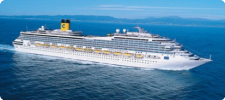The global cruise industry has adopted three new safety policies that are to be implemented with immediate effect. They cover passage planning, personnel access to the bridge, and lifejackets.

Speaking at a European Commission-organised Passenger Ship Safety event in Brussels, Manfredi Lefebvre, Chairman of the European Cruise Council and member of the Cruise Lines International Association Executive Committee, outlined how these policies have been agreed by the industry and represent the third such announcement arising from the cruise industry’s Operational Safety Review.
He also announced that the Operational Safety Review will be further strengthened through the appointment of a panel of four independent experts who were consulted on the three announced measures and will be consulted on future proposals. They are Stephen Meyer, Willem de Ruiter, Mark Rosenker and Dr Jack Spencer.
The three new policies, which go beyond even the strictest of regulatory requirements, address the following issues. Each of these three policies will be reported to the IMO’s Maritime Safety Committee for consideration at their next session in May:
Passage Planning – Although cruise lines have followed IMO guidance on passage planning for many years, the policy now deems this to be a mandatory minimum requirement and enhanced by endorsement of the best practices contained in the International Chamber of Shipping’s Bridge Procedures Guide. Furthermore, under this policy each passage plan is to be thoroughly briefed to all bridge team members well in advance of its implementation and it is to be drafted by a designated officer and approved by the master.
Personnel Access to the Bridge – To minimise unnecessary disruptions and distractions on the bridge the new policy is that bridge access is to be limited to those with operational functions during any period of restricted manoeuvring or when increased vigilance is required.
Lifejackets – In addition to the statutory requirement of carriage of lifejackets for each person onboard, the industry has adopted a policy of carrying additional adult lifejackets onboard each cruise ship in excess of these legal requirements so that the number of additional adult lifejackets to be provided must not be less than the total number of persons berthed within the ship’s most populated main vertical fire zone. This ensures that the number of lifejackets carried is far in excess of the number of persons actually onboard the ship.
Manfredi Lefebvre said: “Today’s European Commission event is in perfect alignment with our industry efforts to improve cruise ship safety. I am pleased to be given a chance by European Commissioner VP & Transport Commissioner Siim Kallas to outline how the industry and the regulators can move forward together in our common goal of preventing future accidents.
“The cruise industry is highly regulated and it is this regulatory regime, complied with onboard by our professional and committed officers and crews, that has given the cruise industry a truly remarkable safety record. But as the Concordia incident demonstrates, there is no such thing as perfect safety. We do strive for a perfect commitment to safety. As part of our commitment to a safety culture, the industry – both individually as cruise lines and collectively through CLIA and the ECC – beginning 27th January launched an Operational Safety Review to learn the lessons from Concordia and to conduct a top to bottom safety review.
“By bringing forward voluntary initiatives such as these, we significantly and immediately improve safety standards. These initiatives are, we believe, fully supportive of the Commission’s goal of re-launching their ‘Quality Shipping Campaign’ through voluntary partnership agreements with the shipping industry as set out in its Maritime Policy 2009- 2018. Specifically, we very much hope that the results of the Operational Safety Review as they are delivered over the coming months will give us fertile ground to grow our partnership with the Commission.
“We are convinced that this approach will achieve concrete, practical and significant safety dividends in the shortest possible time and fully reflects the measured and responsible progress on future safety initiatives by both the Commission and European Parliament following the Concordia tragedy.”
The new policies follows the industry’s announcement on 27th January of an Operational Safety Review in response to the Concordia incident and as part of the industry’s continuous efforts to review and improve safety measures, and represent the third such announcement. The previous two related to the new Muster Drill Policy (9th February 2012) and Enhanced Reporting Requirements to Ensure Consistency, Transparency of Marine Casualty Data (21st March 2012).



These are simple common sense steps that should have been best practice for the safety of passengers in the first place. However, the biggest problem of all is still not addressed. The fundamental problem is launching life boats when a ship begins to list. With the height of these vessels a slight list at the waterline becomes a major shift on the upper decks making at least 50% of life boats unusable and the rest very difficult to release. This problem has been around since the Titanic at least and yet the industry has not come up with a solution.